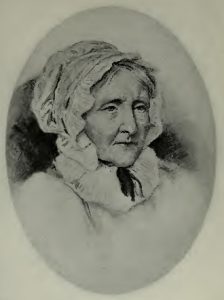“Old Lady Hamilton”: A Woman Who Knew History

January 31, [1839] Old Lady Hamilton was in the office this morning; she’s as spry as usual. She had walked down from St. Mark’s Place and was going to walk back, which is certainly doing very well for an old lady of her degree of antiquity. . . .[i]
George Templeton Strong’s diaries are often quoted or referenced in Civil War studies, and he was influential in the establishment of the U.S. Sanitary Commission. However, he started journaling in 1835, and his writings are a wonderful resource for who’s-who in 19th Century New York City social circles. One of the names that caught my eye in the early years of his writings: “Old Lady Hamilton. She came to the lawyers’ office “about the fortieth alteration of her will and divers other responsibilities.”[ii]
That’s actually a reference to Elizabeth Schuyler Hamilton. Yes, Alexander Hamilton’s wife. She lived until 1854, passing her 97th birthday.
According to Strong, she was remarkably cheerful and full of anecdotes when he paid New Year’s Day calls several years in a row to leave a business calling card since he worked for the law firm that represented her. In January 1840—a particularly cold winter—“Mrs. Hamilton. . .said it was a mere trifle, nothing at all to the winter of 1780.”[iii]
It’s remarkable to think that a woman who witnessed “the Hard Winter” of the Revolutionary War was alive until just seven years before the firing on Fort Sumter. Think of all the history she saw! From the War for Independence through the founding of the government, the War of 1812, the Jacksonian Age, the Mexican-American War era, and many of the milestone events that led to the Civil War.
By the time George Templeton Strong in his late teens and twenties wrote about “Old Lady Hamilton,” she had organized her husband’s thousands of papers and started petitioning the U.S. Congress to purchase and publish them. She succeeded in August 1848, ensuring that a valuable collection of Early American History would be preserved. Just a few months after her great success, she visited her lawyers’ offices again, much to Strong’s annoyance:
November 6, 1848 For this morning, nothing very special. . . . Old Mrs. Hamilton came in. I don’t believe that old lady has the slightest intention of ever going to a better world: such a specimen of juvenile antediluvianism I never encountered. . . .[iv]
Elizabeth Hamilton lived a full life and left a legacy of preserving, writing, and rewriting documents that she hoped would blend “with the vital interest and permanent prosperity of the American people” and be “distinguished for enlighten patriotism and the most elected system of policy.”[v] The portrait of her in Strong’s diary is not the most flattering at times, but it’s one of the remarkable primary sources moments where we can remember just how close the Revolutionary War and Civil War occur on the historic timeline. Perhaps “Old Lady Hamilton” is one of the most literal examples of the concept that “Women Know History.” She lived and preserved a lifetime of crucial documents to help America have the resources to understand the nation’s founding past even as she saw a stormy future ahead.
Sources:
[i] George Templeton Strong, The Diary of George Templeton Strong: Young Man in New York, 1835-1849 (New York: Macmillan, 1952). Page 98.
[iii] Ibid., 121.
[iv] Ibid., 334.
[v] Petition of Elizabeth Hamilton to the U.S. Congress, 1846. Accessed: https://www.docsteach.org/documents/document/petition-hamilton-congress
